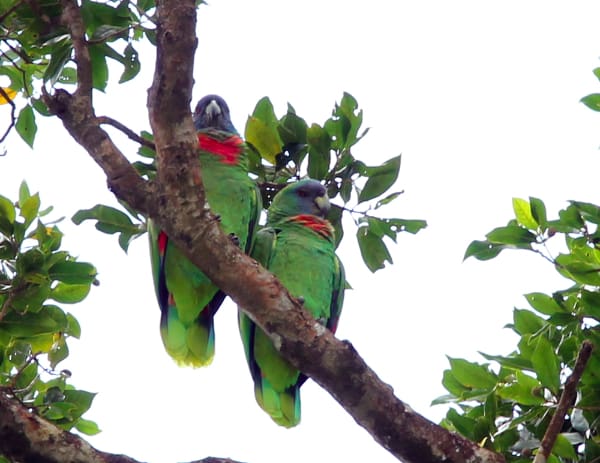The Red-necked Amazon (Amazona arausiaca) has had its population decimated by human disturbance. Its population numbers fewer than 1500 individuals.
In 2001, WPT collaborated with the Rare Species Conservatory Foundation on Dominica to purchase a new all-terrain vehicle and purchase land for a preserve, providing an educational bus to extend outreach on native parrots and monitoring Red-necked Amazon ecology and status in the wild.
The combination of habitat loss through crop planting, hurricane damage, hunting for food and trapping for the pet trade have reduced Red-necked Amazon populations. Successful local education, land preservation and conservation have slowed losses.
In 2001, the World Parrot Trust helped to fund the purchase of land to create a national park to protect these birds. The Canadian arm of the WPT donated funds received through the Donner Canadian Foundation to the Rare Species Conservatory Foundation for their work in Dominica. Funds were used for monitoring and field research, a new all-terrain vehicle to navigate the rough roads in the area, land purchases to create a buffer zone on the edge of the national park, and finishing the Visitor Centre of the park. In previous years, the WPT provided a successful education bus fitted with video, audio and printed materials, to teach about the benefits of conservation.
The WPT provided financial support for the conservation program again in 2010 and 2013 as a result of a visit by the annual Parrot Lovers Cruise.
Status: IUCN Vulnerable / CITES Appendix I
Population: 1200-1500
Range: Dominica, Lesser Antilles, West Indies.
Natural history: The Red-necked Amazon is found from 300-800 m (984-2624 ft) in the canopy of mountain rainforest, preferring Dacryodes excelsa stands. The species was formerly a regular visitor to coastal areas. Birds feed on fruits, buds and some cultivated oranges, and are seen in pairs or small groups with larger flocks formed outside of breeding season. Roosting is at traditional communal sites and feeding early morning and evening.

